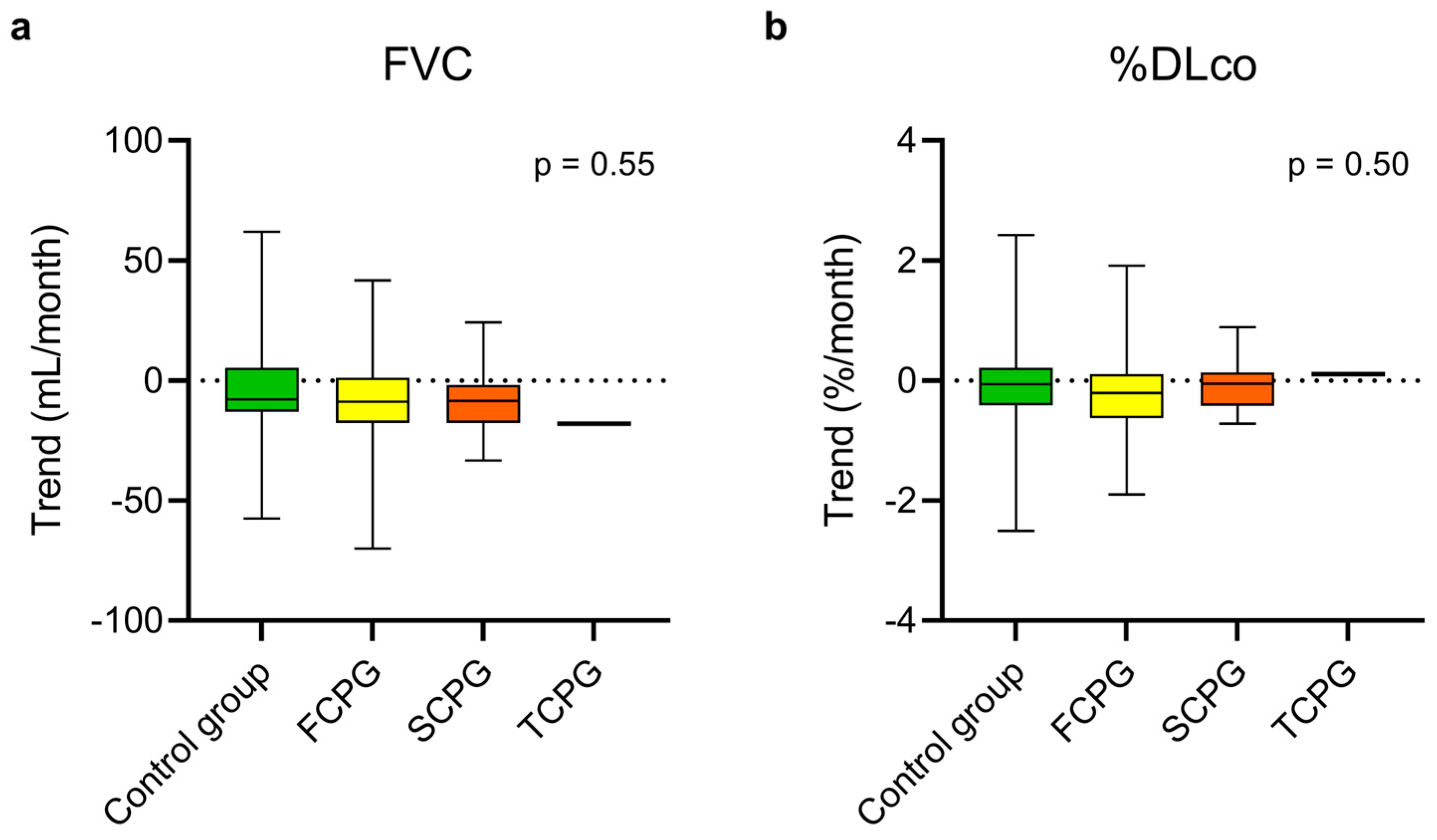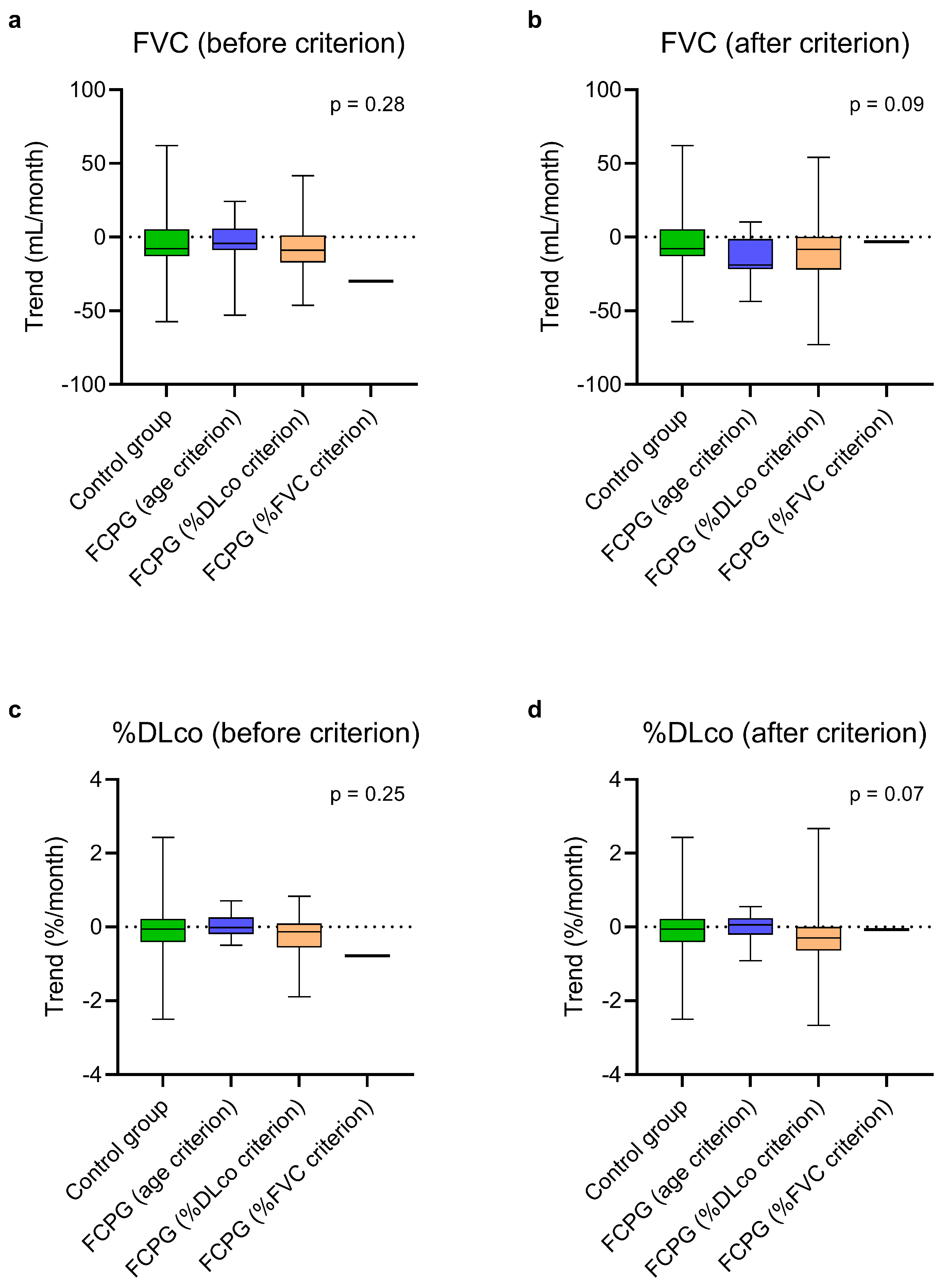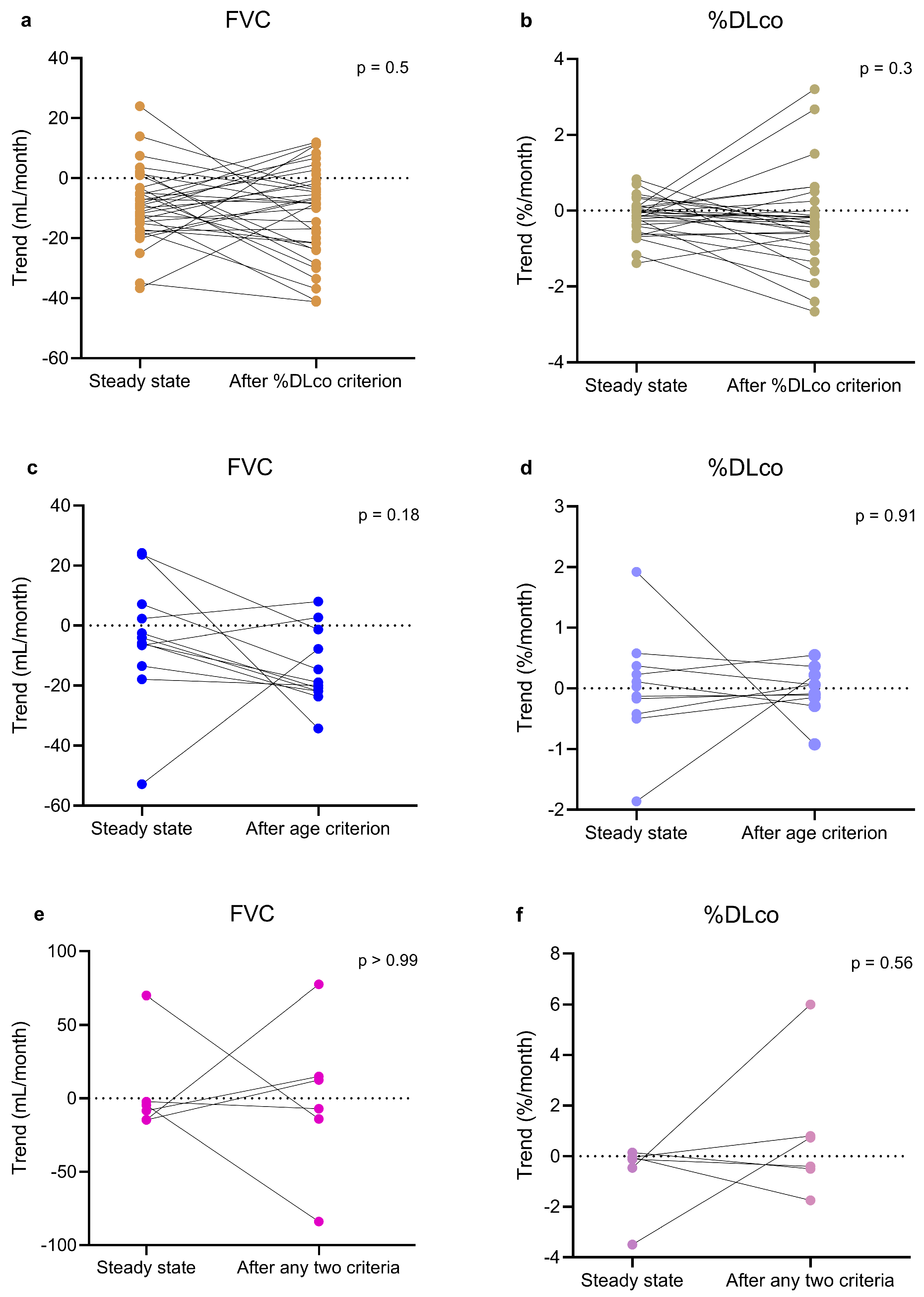Maintenance of Effectiveness of Pirfenidone in Elderly Patients with Progressive Functional Impairment: A Real-World Retrospective Study in IPF †
Abstract
1. Introduction
2. Materials and Methods
2.1. Study Design and Participants
2.2. Effectiveness Outcomes and Comparisons
2.3. Therapeutic Management
2.4. Statistical Analysis
3. Results
3.1. Study Population
3.2. Comparisons Between Control Group and Study Group
3.3. Comparisons Within the Study Group
4. Discussion
5. Conclusions
Supplementary Materials
Author Contributions
Funding
Institutional Review Board Statement
Informed Consent Statement
Data Availability Statement
Acknowledgments
Conflicts of Interest
Abbreviations
| ATS | American Thoracic Society |
| BMI | Body mass index |
| DLco | Diffusion capacity of the lung for carbon monoxide |
| ERS | European Respiratory Society |
| FCPG | First criterion passed group |
| FVC | Forced vital capacity |
| GAP | Gender-age-physiology |
| HRCT | High resolution computer tomography |
| IPF | Idiopathic pulmonary fibrosis |
| IQR | Interquartile range |
| LTOT | Long-term oxygen therapy |
| NA | Not applicable |
| PFTs | Pulmonary function tests |
| SCPG | Second criterion passed group |
| SD | Standard deviation |
| TCPG | Third criterion passed group |
| UIP | Usual interstitial pneumonia |
| %DLco | Percentage of predicted DLco value |
| %FVC | Percentage of predicted FVC value |
References
- Raghu, G.; Rochwerg, B.; Zhang, Y.; Garcia, C.A.C.; Azuma, A.; Behr, J.; Brozek, J.L.; Collard, H.R.; Cunningham, W.; Homma, S.; et al. An official ATS/ERS/JRS/ALAT clinical practice guideline: Treatment of idiopathic pulmonary fibrosis: An update of the 2011 clinical practice guideline. Am. J. Respir. Crit. Care Med. 2015, 192, e3–e19, Erratum in Am. J. Respir. Crit. Care Med. 2015, 192, 644. [Google Scholar] [CrossRef]
- Noble, P.W.; Albera, C.; Bradford, W.Z.; Costabel, U.; Glassberg, M.K.; Kardatzke, D.; King, T.E., Jr.; Lancaster, L.; Sahn, S.A.; Szwarcberg, J.; et al. Pirfenidone in patients with idiopathic pulmonary fibrosis (CAPACITY): Two randomised trials. Lancet 2011, 377, 1760–1769. [Google Scholar] [CrossRef]
- King, T.E., Jr.; Bradford, W.Z.; Castro-Bernardini, S.; Fagan, E.A.; Glaspole, I.; Glassberg, M.K.; Gorina, E.; Hopkins, P.M.; Kardatzke, D.; Lancaster, L.; et al. A Phase 3 Trial of Pirfenidone in Patients with Idiopathic Pulmonary Fibrosis. N. Engl. J. Med. 2014, 370, 2083–2092. [Google Scholar] [CrossRef]
- Nathan, S.D.; Costabel, U.; Albera, C.; Behr, J.; Wuyts, W.A.; Kirchgaessler, K.-U.; Stauffer, J.L.; Morgenthien, E.; Chou, W.; Limb, S.L.; et al. Pirfenidone in patients with idiopathic pulmonary fibrosis and more advanced lung function impairment. Respir. Med. 2019, 153, 44–51. [Google Scholar] [CrossRef] [PubMed]
- Costabel, U.; Albera, C.; Glassberg, M.K.; Lancaster, L.H.; Wuyts, W.A.; Petzinger, U.; Gilberg, F.; Kirchgaessler, K.-U.; Noble, P.W. Effect of pirfenidone in patients with more advanced idiopathic pulmonary fibrosis. Respir. Res. 2019, 20, 55. [Google Scholar] [CrossRef]
- European Medicines Agency: Summary of Product Characteristics—Esbriet (Pirfenidone). Available online: https://www.ema.europa.eu/en/documents/product-information/esbriet-epar-product-information_en.pdf (accessed on 24 September 2025).
- Levra, S.; Rivero, C.; Bertolini, F.; Carriero, V.; Arrigo, E.; Guida, G.; Pizzimenti, S.; Crosa, F.; Albera, C.; Ricciardolo, F.L.M.; et al. Effectiveness of pirfenidone in elderly patients with advanced functional impairment: A real-world study in idiopathic pulmonary fibrosis. Eur. Respir. J. 2024, 64 (Suppl. 68), PA5144. [Google Scholar] [CrossRef]
- Raghu, G.; Collard, H.R.; Egan, J.J.; Martinez, F.J.; Behr, J.; Brown, K.K.; Colby, T.V.; Cordier, J.-F.; Flaherty, K.R.; Lasky, J.A.; et al. An Official ATS/ERS/JRS/ALAT Statement: Idiopathic pulmonary fibrosis: Evidence-based guidelines for diagnosis and management. Am. J. Respir. Crit. Care Med. 2011, 183, 788–824. [Google Scholar] [CrossRef] [PubMed]
- Raghu, G.; Remy-Jardin, M.; Myers, J.L.; Richeldi, L.; Ryerson, C.J.; Lederer, D.J.; Behr, J.; Cottin, V.; Danoff, S.K.; Morell, F.; et al. Diagnosis of idiopathic pulmonary fibrosis An Official ATS/ERS/JRS/ALAT Clinical practice guideline. Am. J. Respir. Crit. Care Med. 2018, 198, e44–e68. [Google Scholar] [CrossRef] [PubMed]
- Raghu, G.; Remy-Jardin, M.; Richeldi, L.; Thomson, C.C.; Inoue, Y.; Johkoh, T.; Kreuter, M.; Lynch, D.A.; Maher, T.M.; Martinez, F.J.; et al. Idiopathic Pulmonary Fibrosis (an Update) and Progressive Pulmonary Fibrosis in Adults: An Official ATS/ERS/JRS/ALAT Clinical Practice Guideline. Am. J. Respir. Crit. Care Med. 2022, 205, e18–e47. [Google Scholar] [CrossRef]
- Miller, M.R.; Hankinson, J.; Brusasco, V.; Burgos, F.; Casaburi, R.; Coates, A.; Crapo, R.; Enright, P.; van der Grinten, C.P.M.; Gustafsson, P.; et al. Standardisation of spirometry. Eur. Respir. J. 2005, 26, 319–338. [Google Scholar] [CrossRef]
- Graham, B.L.; Steenbruggen, I.; Miller, M.R.; Barjaktarevic, I.Z.; Cooper, B.G.; Hall, G.L.; Hallstrand, T.S.; Kaminsky, D.A.; McCarthy, K.; McCormack, M.C.; et al. Standardization of Spirometry 2019 Update. An Official American Thoracic Society and European Respiratory Society Technical Statement. Am. J. Respir. Crit. Care Med. 2019, 200, e70–e88. [Google Scholar] [CrossRef]
- Motulsky, H.J.; Brown, R.E. Detecting outliers when fitting data with nonlinear regression—A new method based on robust nonlinear regression and the false discovery rate. BMC Bioinformatics 2006, 7, 123. [Google Scholar] [CrossRef]
- Costabel, U.; Albera, C.; Lancaster, L.H.; Lin, C.-Y.; Hormel, P.; Hulter, H.N.; Noble, P.W. An Open-Label Study of the Long-Term Safety of Pirfenidone in Patients with Idiopathic Pulmonary Fibrosis (RECAP). Respiration 2017, 94, 408–415. [Google Scholar] [CrossRef]
- Levra, S.; Guida, G.; Sprio, A.E.; Crosa, F.; Ghio, P.C.; Bertolini, F.; Carriero, V.; Albera, C.; Ricciardolo, F.L.M. Long-Term Safety of Antifibrotic Drugs in IPF: A Real-World Experience. Biomedicines 2022, 10, 3229. [Google Scholar] [CrossRef]
- Behr, J.; Nathan, S.D.; Costabel, U.; Albera, C.; Wuyts, W.A.; Glassberg, M.K.; Haller, H., Jr.; Alvaro, G.; Gilberg, F.; Samara, K.; et al. Efficacy and Safety of Pirfenidone in Advanced Versus Non-Advanced Idiopathic Pulmonary Fibrosis: Post-Hoc Analysis of Six Clinical Studies. Adv. Ther. 2023, 40, 3937–3955. [Google Scholar] [CrossRef]
- Tzouvelekis, A.; Ntolios, P.; Karampitsakos, T.; Tzilas, V.; Anevlavis, S.; Bouros, E.; Steiropoulos, P.; Koulouris, N.; Stratakos, G.; Froudarakis, M.; et al. Safety and efficacy of pirfenidone in severe Idiopathic Pulmonary Fibrosis: A real-world observational study. Pulm. Pharmacol. Ther. 2017, 46, 48–53. [Google Scholar] [CrossRef] [PubMed]
- Yoon, H.Y.; Kim, D.S.; Song, J.W. Efficacy and Safety of Pirfenidone in Advanced Idiopathic Pulmonary Fibrosis. Respiration 2019, 97, 242–251. [Google Scholar] [CrossRef] [PubMed]
- Chung, M.P.; Park, M.S.; Oh, I.J.; Lee, H.B.; Kim, Y.W.; Park, J.S.; Uh, S.T.; Kim, Y.S.; Jegal, Y.; Song, J.W. Safety and Efficacy of Pirfenidone in Advanced Idiopathic Pulmonary Fibrosis: A Nationwide Post-Marketing Surveillance Study in Korean Patients. Adv. Ther. 2020, 37, 2303–2316. [Google Scholar] [CrossRef] [PubMed]
- Taguchi, Y.; Ebina, M.; Hashimoto, S.; Ogura, T.; Azuma, A.; Taniguchi, H.; Kondoh, Y.; Suga, M.; Takahashi, H.; Nakata, K.; et al. Efficacy of pirfenidone and disease severity of idiopathic pulmonary fibrosis: Extended analysis of phase III trial in Japan. Respir. Investig. 2015, 53, 279–287. [Google Scholar] [CrossRef]
- Nathan, S.D.; Albera, C.; Bradford, W.Z.; Costabel, U.; du Bois, R.M.; Fagan, E.A.; Fishman, R.S.; Glaspole, I.; Glassberg, M.K.; Glasscock, K.F.; et al. Effect of continued treatment with pirfenidone following clinically meaningful declines in forced vital capacity: Analysis of data from three phase 3 trials in patients with idiopathic pulmonary fibrosis. Thorax. 2016, 71, 429–435. [Google Scholar] [CrossRef]
- Sakamoto, S.; Itoh, T.; Muramatsu, Y.; Satoh, K.; Ishida, F.; Sugino, K.; Isobe, K.; Homma, S. Efficacy of pirfenidone in patients with advanced-stage idiopathic pulmonary fibrosis. Intern. Med. 2013, 52, 2495–2501. [Google Scholar] [CrossRef] [PubMed]
- Loeh, B.; Drakopanagiotakis, F.; Bandelli, G.P.; von der Beck, D.; Tello, S.; Cordani, E.; Rizza, E.; Barrocu, L.; Markart, P.; Seeger, W.; et al. Intraindividual response to treatment with pirfenidone in idiopathic pulmonary fibrosis. Am. J. Respir. Crit. Care Med. 2015, 191, 110–113. [Google Scholar] [CrossRef] [PubMed]
- Arai, T.; Inoue, Y.; Sasaki, Y.; Tachibana, K.; Nakao, K.; Sugimoto, C.; Okuma, T.; Akira, M.; Kitaichi, M.; Hayashi, S. Predictors of the clinical effects of pirfenidone on idiopathic pulmonary fibrosis. Respir. Investig. 2014, 52, 136–143. [Google Scholar] [CrossRef] [PubMed]
- Harari, S.; Caminati, A.; Albera, C.; Vancheri, C.; Poletti, V.; Pesci, A.; Luppi, F.; Saltini, C.; Agostini, C.; Bargagli, E.; et al. Efficacy of pirfenidone for idiopathic pulmonary fibrosis: An Italian real life study. Respir. Med. 2015, 109, 904–913. [Google Scholar] [CrossRef]
- Sakayori, M.; Terada, J.; Abe, M.; Hirasawa, Y.; Suzuki, K.; Yoshioka, K.; Tsushima, K.; Tatsumi, K. Differences in tolerability of pirfenidone between elderly and younger patients with idiopathic pulmonary fibrosis. Drug Des. Devel. Ther. 2019, 13, 2295–2303. [Google Scholar] [CrossRef]





| Characteristic | Control Group (n = 76) | Study Group (n = 98) | ||
|---|---|---|---|---|
| One Criterion Passed (n = 72) | Two Criteria Passed (n = 25) | Three Criteria Passed (n = 1) | ||
| Age, years | ||||
| Mean (SD) | 71.9 (6.4) | 70.7 (6.3) | 73.3 (6.8) | 78 |
| Minimum | 41 | 53 | 54 | 78 |
| Median | 74 | 71 | 76 | 78 |
| Maximum | 80 | 80 | 80 | 78 |
| Sex | ||||
| Male, n (%) | 65 (84.4) | 59 (81.9) | 22 (88) | 1 (100) |
| Smoking history | ||||
| Current/former smoker, n (%) | 56 (73.7) | 54 (75) | 17 (68) | 0 |
| Never smoker, n (%) | 20 (26.3) | 18 (25) | 8 (32) | 1 (100) |
| Pack-years | 31.9 (21.2) | 32.4 (21.5) | 22.9 (15.9) | NA |
| Diagnostic features | ||||
| HRCT pattern | ||||
| UIP, n (%) | 56 (73.7) | 57 (79.2) | 17 (68) | 0 |
| UIP probable, n (%) | 19 (25) | 14 (19.4) | 8 (32) | 1 (100) |
| Indeterminate for UIP, n (%) | 1 (1.3) | 1 (1.4) | 0 | 0 |
| Lung biopsy, n (%) | 16 (21) | 5 (6.9) | 6 (24) | 0 |
| Histological pattern | ||||
| UIP, n (%) | 10 (62.5) | 3 (60) | 2 (33.3) | NA |
| UIP probable, n (%) | 4 (25) | 1 (20) | 3 (50) | NA |
| Indeterminate for UIP, n (%) | 2 (12.5) | 1 (20) | 1 (16.7) | NA |
| Functional parameters | ||||
| FVC, l | 2.7 (0.6) | 2.7 (0.7) | 2.4 (0.4) **° | 2.9 |
| FVC, % of predicted value | 86.5 (18.3) | 82.3 (16.9) | 75 (14.2) | 85 |
| DLco, % of predicted value | 56 (14.5) | 49.2 (11.8) ** | 48.3 (11.2) * | 63 |
| Home oxygen therapy, n (%) | 4 (5.3) | 16 (22.2) ** | 6 (24) * | 0 |
| BMI, kg/m2 | 27.6 (4) | 29.5 (4.5) | 32.3 (4) | 28.2 |
| Prognostic tools | ||||
| GAP index, points | 3.6 (1) | 3.6 (0.9) | 4.2 (1.1) | 2 |
| Analyzed time | ||||
| Steady state, months | 29.8 (30.3) | 21.3 (23.2) | 23.1 (21.4) | 28 |
| After first criterion, months | NA | 14.3 (16.9) | 10.1 (12.4) | 24 |
| After second criterion, months | NA | NA | 4.2 (8.3) | 0 |
| After third criterion, months | NA | NA | NA | 0 |
| Parameter | %DLco Criterion (n = 73) | Age Criterion (n = 18) | %FVC Criterion (n = 2) | Any Two Criteria (n = 26) |
|---|---|---|---|---|
| Steady state | ||||
| FVC, mL/month | ||||
| N. of patients with data | 33 | 12 | 0 | 6 |
| Mean (SD) | −9.02 (18.03) | −4.32 (20.02) | 4.25 (32.6) | |
| Median (IQR) | −9.04 (−17.17–−3.17) | −4.91 (−11.75–5.93) | −6.5 (−14.6–15.84) | |
| %DLco, %/month | ||||
| N. of patients with data | 30 | 10 | 0 | 6 |
| Mean (SD) | −0.16 (0.48) | 0.01 (0.9) | −0.67 (1.4) | |
| Median (IQR) | −0.12 (−0.45–0.09) | −0.01 (−0.44–0.42) | −0.08 (−1.22–0) | |
| After passing a criterion | ||||
| FVC, mL/month | ||||
| N. of patients with data | 33 | 12 | 0 | NA |
| Mean (SD) | −11.24 (15.16) | −14.52 (12.41) | ||
| Median (IQR) | −8.33 (−22.66–−1.2) | −19.45 (−21.82–−2.93) | ||
| p-value | 0.497 | 0.178 | ||
| %DLco, %/month | ||||
| N. of patients with data | 30 | 10 | 0 | NA |
| Mean (SD) | −0.27 (1.23) | −0.03 (0.4) | ||
| Median (IQR) | −0.31 (−0.71–0.06) | −0.01 (−0.18–0.25) | ||
| p-value | 0.301 | 0.913 | ||
| After passing two criteria | ||||
| FVC, ml/month | ||||
| N. of patients with data | NA | NA | NA | 6 |
| Mean (SD) | 0 (52.32) | |||
| Median (IQR) | 2.75 (−31.5–30.63) | |||
| p-value | >0.999 | |||
| %DLco, %/month | ||||
| N. of patients with data | NA | NA | NA | 6 |
| Mean (SD) | 0.81 (2.71) | |||
| Median (IQR) | 0.16 (−0.81–2.1) | |||
| p-value | 0.562 |
Disclaimer/Publisher’s Note: The statements, opinions and data contained in all publications are solely those of the individual author(s) and contributor(s) and not of MDPI and/or the editor(s). MDPI and/or the editor(s) disclaim responsibility for any injury to people or property resulting from any ideas, methods, instructions or products referred to in the content. |
© 2025 by the authors. Licensee MDPI, Basel, Switzerland. This article is an open access article distributed under the terms and conditions of the Creative Commons Attribution (CC BY) license (https://creativecommons.org/licenses/by/4.0/).
Share and Cite
Levra, S.; Rivero, C.; Giannoccaro, F.; Guida, G.; Bertolini, F.; Carriero, V.; Arrigo, E.; Balbi, M.; Albera, C.; Ricciardolo, F.L.M. Maintenance of Effectiveness of Pirfenidone in Elderly Patients with Progressive Functional Impairment: A Real-World Retrospective Study in IPF. Biomedicines 2025, 13, 2809. https://doi.org/10.3390/biomedicines13112809
Levra S, Rivero C, Giannoccaro F, Guida G, Bertolini F, Carriero V, Arrigo E, Balbi M, Albera C, Ricciardolo FLM. Maintenance of Effectiveness of Pirfenidone in Elderly Patients with Progressive Functional Impairment: A Real-World Retrospective Study in IPF. Biomedicines. 2025; 13(11):2809. https://doi.org/10.3390/biomedicines13112809
Chicago/Turabian StyleLevra, Stefano, Cecilia Rivero, Fabiana Giannoccaro, Giuseppe Guida, Francesca Bertolini, Vitina Carriero, Elisa Arrigo, Maurizio Balbi, Carlo Albera, and Fabio Luigi Massimo Ricciardolo. 2025. "Maintenance of Effectiveness of Pirfenidone in Elderly Patients with Progressive Functional Impairment: A Real-World Retrospective Study in IPF" Biomedicines 13, no. 11: 2809. https://doi.org/10.3390/biomedicines13112809
APA StyleLevra, S., Rivero, C., Giannoccaro, F., Guida, G., Bertolini, F., Carriero, V., Arrigo, E., Balbi, M., Albera, C., & Ricciardolo, F. L. M. (2025). Maintenance of Effectiveness of Pirfenidone in Elderly Patients with Progressive Functional Impairment: A Real-World Retrospective Study in IPF. Biomedicines, 13(11), 2809. https://doi.org/10.3390/biomedicines13112809





